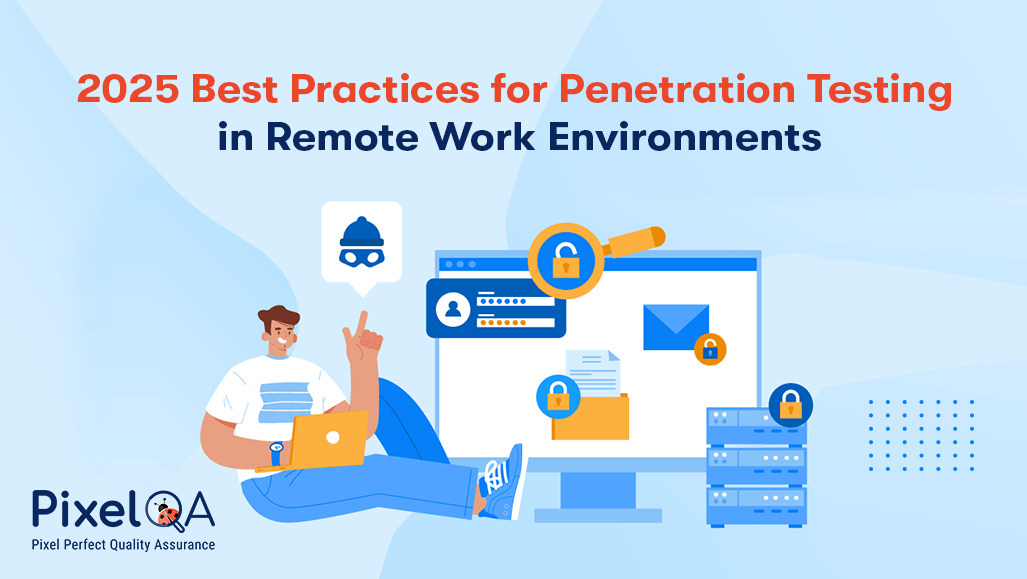
Remote work has transformed the operation of companies over the last few years. As remote and hybrid work models redefine business operations, they bring both opportunities and heightened security risks. In 2025, with businesses adapting to hybrid workspaces, Software Testing Services, particularly Penetration Testing Services, have become essential for safeguarding confidential data and systems. It secures remote work locations and allows errors to be identified before the culprits can use them. Organizations that carry out periodic trial runs are one step ahead of their times regarding emerging threats on the net.
Table of Content
- Why Penetration Testing is Critical for Remote Work Environments
- Best Practices for Penetration Testing Remote Work Environments in 2025
- Conclusion
Why Penetration Testing is Critical for Remote Work Environments
Workers would typically use the corporate network in a cubicle environment from a managed, centralized location that is heavily firewalled. Since they are remote, workers tend to use consumer-grade equipment and less secure home networks than the ones used by the corporation. Consequently, the attack surface has increased, and it has been easier for attackers to exploit vulnerabilities.
Remote work environments face the following cybersecurity challenges:
- Greater Attack Surface: When more employees work with laptops, smartphones, and home PCs to connect to networks, hackers have more attack surfaces.
- Unsecured Home Networks: Because the home Wi-Fi network might not be as protected as corporate networks, remote workers will often use them, leaving them at risk of Man-in-the-Middle (MitM) attacks.
- Personal Device Use: Remote employees often use their own devices, which may lack the latest security patches, to connect to corporate data.
- Lack of Visibility: It is difficult for companies to effectively monitor and manage network traffic when employees are spread out in multiple locations. Our
Security Testing Company can identify these vulnerabilities prior to when evil hackers might take advantage of them through simulating an actual cyberattack.
Best Practices for Penetration Testing Remote Work Environments in 2025
As remote work continues to be a permanent part of the business landscape, penetration testing becomes more important than ever. Here are some best practices for penetration testing remote work environments:
1. Test the Entire Remote Work Ecosystem
Remote employees do more than simply gain access to a company's network from a remote location. They include a broad range of elements, like standalone devices, cloud applications, BYOD policies, VPNs, and groupware like Microsoft Teams or Slack. One should test the whole ecosystem, not just the company's network, when performing penetration testing.
There is a need for penetration testers to test the following:
- Cloud Infrastructure: AWS, Azure, and Google Cloud are among the cloud services most companies use for remote access. To ensure that data access rules are in place and the systems are secure, pen testers must assess cloud configurations.
- Personal Devices: Penetration testers need to scan the security of personal devices that employees use frequently to gain access to company data. One must scan tablets, laptops, and mobile phones for antiquated software, malicious apps, and probable threats.
- Wi-Fi Networks: To determine whether attackers can avoid poor encryption methods or intercepting traffic, penetration testers must simulate attacks on home Wi-Fi networks.
Companies can identify security vulnerabilities in all aspects of the remote workplace setup and address issues that otherwise might not be discovered by testing the entire environment.
2. Implement Regular, Ongoing Penetration Testing
Penetration testing sometimes entails interfering with systems and networks, and this may influence remote workers' productivity. Organizations need to involve the employees to discuss that the tests are a component of the security improvements being carried out by the company. This will help address potential disruptions as well as notify remote workers about changes or upgrades in the network.
Penetration testers also need to collaborate with the IT and security departments to give input on their findings and assist in prioritizing what vulnerabilities must be addressed immediately.
3. Simulate Real-World Attacks
Through mimicking a real attack, our Penetration Testing Services helps find weaknesses before the bad guys have a chance to exploit them. In remote working environments, moral hackers need to think like attackers and use methods inspired by maleficent parties.
Penetration testers should use a mix of techniques, including:
- Phishing Simulations: Phishing messages are also used by hackers commonly to lure staff members into releasing confidential details or installing unwanted programs. To assess if they can be phished, the pen testers will need to carry out an examination and undergo suitable security awareness training.
- Social Engineering: Along with technical techniques, penetration testers should attempt social engineering techniques on employees to get them to reveal credentials, passwords, or other personal information.
- Taking Advantage of Remote Access System Vulnerabilities: The hackers will seek to take advantage of vulnerabilities in remote access systems, for example, remote desktop protocols (RDP) or virtual private networks (VPNs). Pen testers will seek to use these vulnerabilities to gain entry into remote operating systems.
- Privilege Escalation: Once initial access has been gained, penetration testers ought to attempt to elevate their privileges by laterally moving across the network. This replicates the actions of an attacker who has penetrated the perimeter
- Data Exfiltration: Leaks and vulnerabilities where sensitive information may be stolen during an attack can be identified by simulating data theft.
Through performing different forms of attacks, companies will be able to better understand how effective their security against real threats is
4. Collaborate with Remote Workers
Penetration testing is a continuous process. As the threat environment changes, it is crucial that companies continue to test their remote work environments. It has to be done on a regular basis considering the constantly changing nature of remote working technologies, changing hacker methods, and newly discovered vulnerabilities.
While an extensive pen test every year is a great starting point, companies should consider doing smaller, regular testing, e.g., quarterly testing, particularly after significant updates or enhancements to the remote work setup. This way industries can secure their and clients’ data and mitigate all the issues.
5. Provide Detailed, Actionable Reports
Discovery of vulnerabilities is but one of the final goals of penetration testing; another is to provide accurate, feasible recommendations for improvement. Providing detailed reports that enumerate the discovered vulnerabilities, the severity of each issue, and specific measures to minimize risks is important after penetration testing.
- These reports should include:
- A summary of the penetration testing process.
- a catalog of vulnerabilities discovered and their potential impact.
- remedial recommendations, such as updating encryption methods, patching outdated software, or enhancing employee training.
Organizations should focus their cybersecurity initiatives and address the most critical issues first if they are provided with all penetration reports.
Conclusion
Penetration testing is important for companies with off-site labor to validate the security of off-site environments. Regular testing, regular scanning, and ongoing adjustment to emerging cybersecurity threats guarantee robust defenses, reduce attack risks, and provide a secure work environment for remote workers.
About Author

Rushi Mistry is a Security Analyst at PixelQA a Software Testing Company with a focus on cybersecurity. He is passionate about IoT penetration testing and is working towards obtaining a CISSP certification, with the ultimate goal of becoming a Chief Information Security Officer (CISO).

_638811705539874132.png)